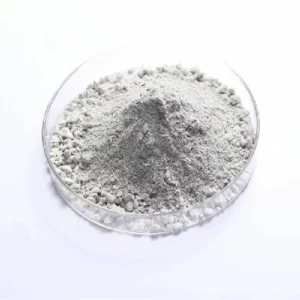Gunning castable is prepared and applied in practice using a specific process.
Here is an overview of how gunning castable is prepared and applied:
Mixing: Gunning castable is typically prepared by thoroughly mixing dry refractory aggregates, binders, and additives. The exact composition depends on the specific requirements of the application and the manufacturer’s instructions.
Adding Water: Water is gradually added to the dry mix while continuously mixing. The amount of water added should be carefully controlled to achieve the desired consistency. The water helps activate the binders and facilitates the application process.
Mixing and Conditioning: The mixture is further mixed and conditioned to ensure a homogeneous and workable consistency. This step helps to eliminate lumps and ensure proper distribution of the materials.
Loading the Gunning Machine: The prepared gunning castable is loaded into a gunning machine, which is a device that pneumatically projects the castable onto the target surface using compressed air.
Application: The gunning machine is positioned near the target surface, and the operator directs the nozzle towards the area that requires refractory lining or repair. The compressed air propels the gunning castable onto the surface at high velocity.
Gunning Process: The operator moves the gunning nozzle in a controlled manner, applying the castable evenly and building up the desired thickness or shape. The gunning process may involve layering or multiple passes to achieve the desired thickness and compaction.
Finishing and Smoothing: After the initial application, the gunning castable can be smoothed and compacted using trowels or other tools to improve the surface finish and remove any excess material.
Curing and Drying: Once the gunning castable is applied, it should be allowed to cure and dry according to the manufacturer’s recommendations. Curing time and temperature conditions may vary depending on the specific product.
It’s important to note that the exact procedures and techniques may vary based on the specific type and manufacturer of gunning castable. It is crucial to follow the manufacturer’s instructions and guidelines for proper preparation, application, and curing of the gunning castable to ensure optimal performance and longevity of the refractory lining.
What are the curing and drying procedures for gunning castable?
The curing and drying procedures for gunning castable may vary depending on the specific product and manufacturer’s recommendations.
However, here are some general guidelines that are commonly followed:
Initial Setting Time: Gunning castable typically has an initial setting time, which is the time it takes for the castable to begin to harden after application. During this period, it is important to avoid disturbing or disturbing the castable to allow it to set properly.
Moist Curing: Gunning castable often requires a period of moist curing to ensure proper hydration and strength development. Gunning castable Moist curing involves keeping the castable damp by spraying or misting water on the surface. This helps prevent rapid drying and promotes the formation of strong and durable bonds within the castable.
Curing Temperature: Some gunning castables may have specific temperature requirements during the curing process. It is important to follow the manufacturer’s instructions regarding the optimal temperature range for curing. In some cases, controlled heating or insulation may be necessary to maintain the desired temperature.
Curing Duration: The curing duration for gunning castable can vary depending on the specific product, ambient conditions, and application requirements. It typically ranges from several hours to several days. It is important to allow sufficient time for the castable to cure and develop the desired strength before subjecting it to operational or load conditions.
Drying: After the initial curing period, the gunning castable should be allowed to dry. Drying involves the removal of excess moisture from the castable. The drying process may occur naturally through air drying or can be accelerated using controlled heating or air circulation. The duration of the drying process can vary depending on the castable thickness and environmental conditions.
It is crucial to follow the manufacturer’s instructions and recommendations for the specific gunning castable being used. The manufacturer’s guidelines will provide the most accurate information regarding the curing and drying procedures, including recommended curing time, temperature, and moisture control measures. Adhering to these guidelines will help ensure the proper development of the gunning castable’s properties and performance.
